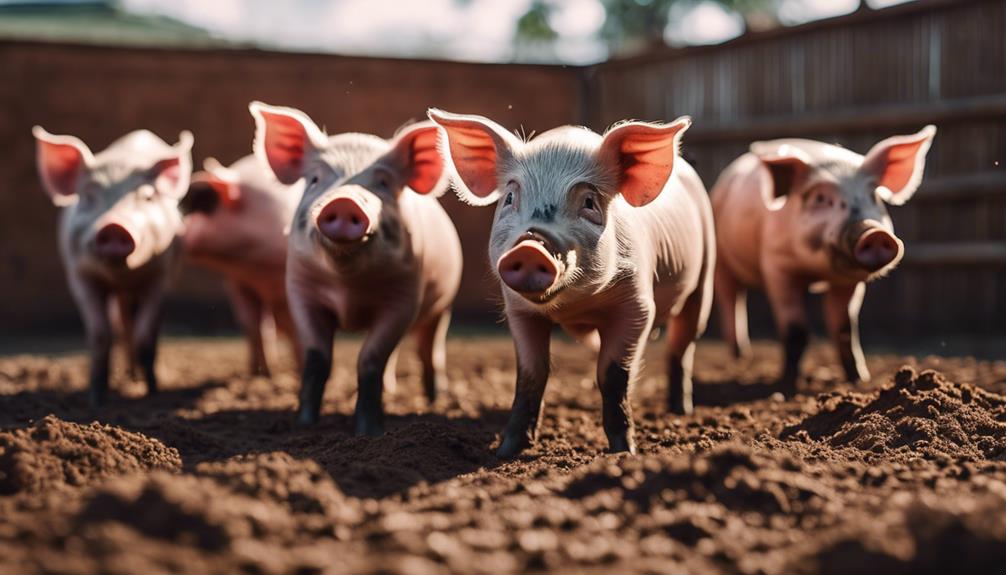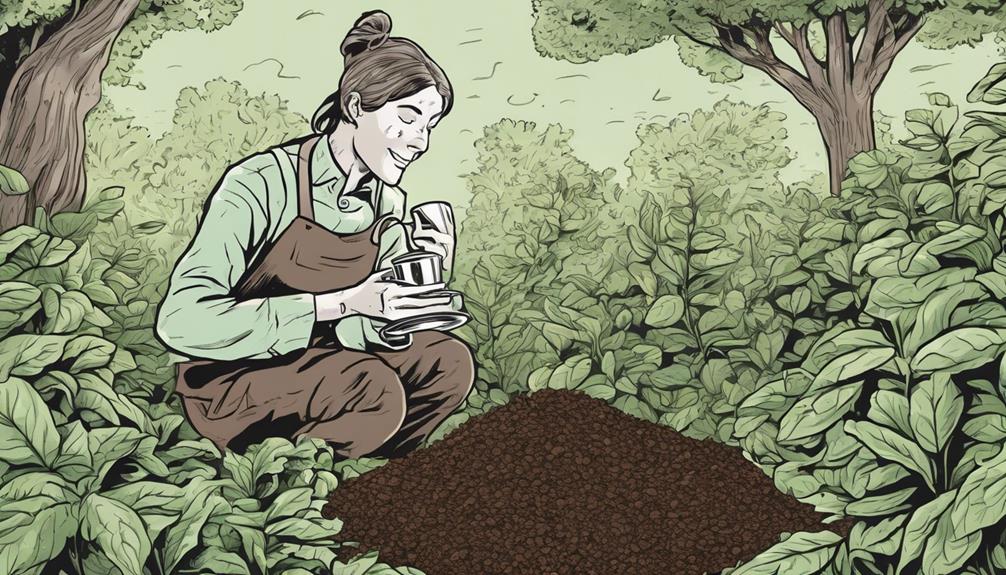You can make coffee at home like a barista by beginning with quality beans from local roasters. Grind the beans just before brewing for the best flavor. Use purified water at the perfect temperature for a clean extraction. Try out different brewing methods such as French press or pour-over for distinct tastes. Keep your equipment clean regularly to preserve freshness. Also, keep in mind that knowing the origin of coffee beans can improve your flavor experience. Prepare yourself to take your home brewing skills to the next level with these tips!
Key Takeaways
- Use quality, locally roasted beans for freshness.
- Grind beans to match brewing method for optimal flavor.
- Maintain precise water temperature for clean extraction.
- Experiment with different brewing methods for diverse flavors.
- Clean equipment regularly for consistent, delicious brews.
Selecting Coffee Beans
To brew coffee like a barista, start by selecting whole bean coffee for freshness and best flavor extraction. When choosing your coffee beans, opt for quality beans sourced from local artisan roasters. These roasters take pride in their craft, ensuring that each batch of beans is carefully roasted to perfection, resulting in a unique and flavorful coffee experience.
By purchasing whole bean coffee, you're preserving the natural oils and flavors that are essential for a rich and aromatic cup of coffee. Grinding the beans just before brewing further enhances the freshness of your coffee, allowing you to savor the true essence of the beans.
Storing your coffee beans properly is also essential. Keep them in airtight containers away from sunlight and moisture to maintain their freshness and flavor profile.
Supporting local artisan roasters not only guarantees a high-quality product but also helps small businesses thrive and promotes the diversity of coffee varieties available to you.
Measuring Coffee
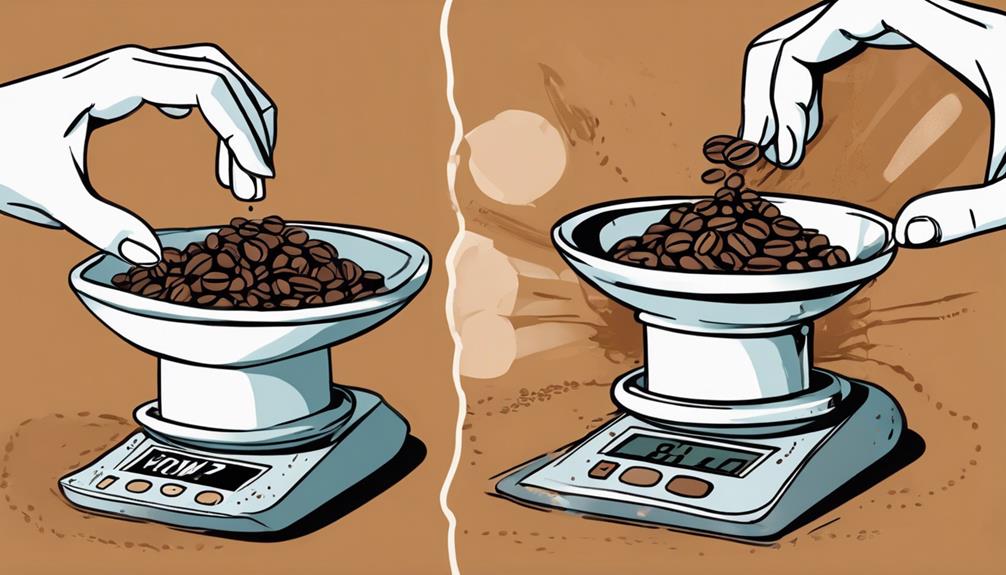
When selecting your coffee beans, it's vital to also pay attention to how you measure your coffee for brewing. To brew a perfect cup at home, measuring your coffee accurately is key. Use a digital scale for precise measurements, ensuring you get the right coffee-to-water ratio.
For example, a common ratio is 2 tablespoons of coffee to 8 fluid ounces of water. Remember, different roasts may require different volumes of coffee, with dark roasts often needing more compared to light roasts.
Following recommended ratios is essential in home brewing. For instance, for a Chemex brew, a ratio of 37 grams of coffee to 16 fluid ounces of water is often suggested. Visual cues on brewers can also assist you in achieving the correct coffee-to-water ratio, but a quality scale will guarantee consistency in your brews.
Grinding Coffee
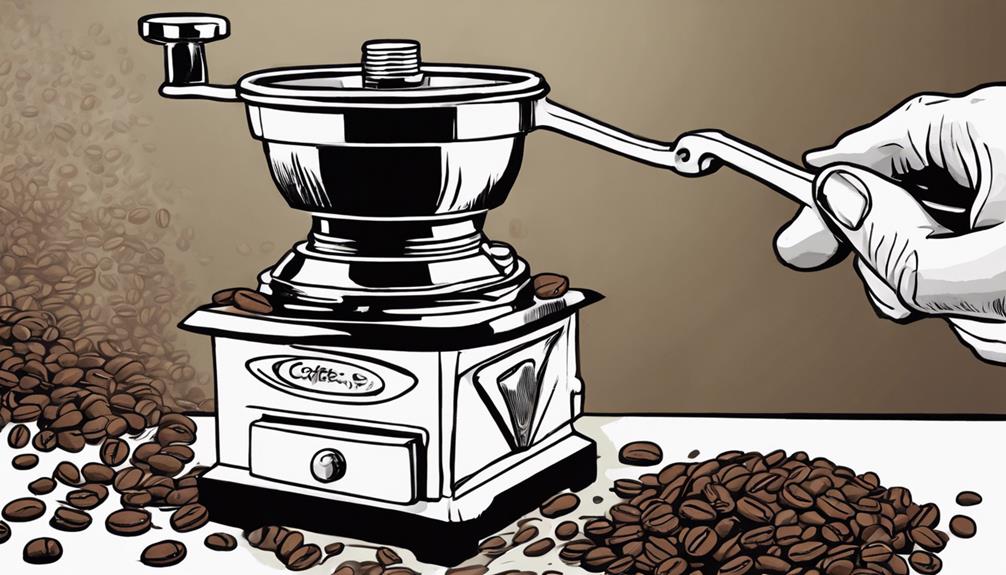
For best freshness and flavor in your coffee, consider grinding only what you need. Using a burr grinder is key to achieving a consistent and even grind size, which is essential for ideal extraction.
The grind size you choose should match your brewing method; coarser grinds work well for French press, while finer grinds are ideal for espresso.
Avoid pre-ground coffee if possible. Pre-ground coffee can result in uneven extraction and stale flavors since the coffee has already been exposed to air, losing its freshness.
Grinding fresh coffee just before brewing is a game-changer; it enhances the overall taste and aroma of your cup.
Investing in a burr grinder will elevate your coffee game, ensuring that each grind is precise and uniform. This precision allows for better control over the extraction process, resulting in a more flavorful and aromatic brew.
Storing Coffee
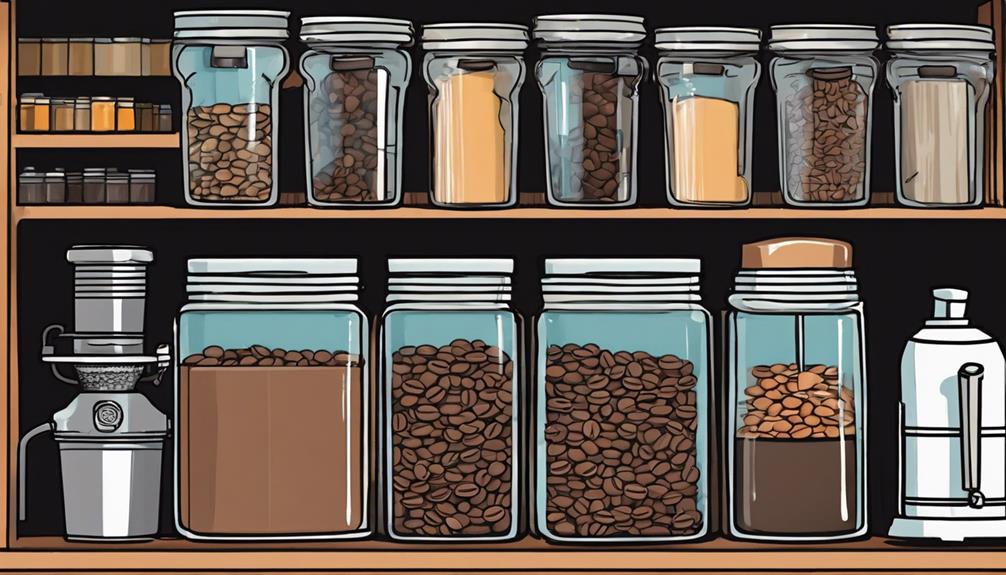
To keep your coffee fresh and flavorful, make sure to store it in airtight containers and shield it from sunlight.
Avoid freezing your coffee, as it can alter its taste and aroma.
Opt for ceramic or glass canisters to maintain the quality of your coffee and keep it away from moisture to prevent staleness and mold growth.
Airtight Containers
Store your coffee beans in hermetically sealed containers to sustain freshness and safeguard their rich flavor. Hermetically sealed containers act as a barrier, shielding your coffee from sunlight, moisture, and air exposure. This aids in upholding the quality of your coffee over time.
When storing coffee, refrain from freezing it as this can adversely affect its taste and aroma. For optimal outcomes, choose ceramic or glass canisters to store your precious coffee beans. These materials are suggested as they assist in sustaining the freshness and flavor of your coffee beans.
By storing your coffee in hermetically sealed containers, you ensure that each brew delivers a delightful and gratifying coffee experience.
- Hermetically sealed containers sustain freshness and flavor.
- Shield coffee from sunlight, moisture, and air exposure.
- Avoid freezing coffee to sustain taste and aroma.
- Ceramic or glass canisters recommended for storage.
- Proper storage helps sustain coffee quality over time.
Sunlight Protection
Keep your coffee beans safe from sunlight by storing them in dark, opaque containers or cabinets to maintain their freshness and flavor.
Sunlight exposure can be harmful to your coffee beans, as it can lead to oxidation and the loss of volatile aromas, ultimately impacting the taste of your brew. To shield your coffee from these effects, keep it in a location away from windows or light sources.
By storing your coffee in airtight containers, you can further safeguard it from sunlight and preserve its best taste and aroma. Remember, the key to a delicious cup of coffee lies in the freshness of the beans, so take the necessary precautions to store your coffee properly.
Water Quality

Enhancing the taste of your coffee starts with using purified water to ensure a clean extraction process. When brewing coffee, water quality plays a vital role in determining the flavor profile of your cup.
Here are some key points to keep in mind:
- Purified water: Eliminates impurities for a cleaner extraction process.
- Water temperature: Ideal range is between 195°F and 205°F for proper extraction.
- Preventing over-extraction: Using purified water helps avoid over-extraction, resulting in a more balanced flavor.
- Impact on taste: Water quality greatly influences the taste of your coffee, highlighting the importance of clean water.
- Freshness maintenance: Storing purified water in the refrigerator helps preserve its freshness, ensuring a consistent brewing environment.
Brewing Methods
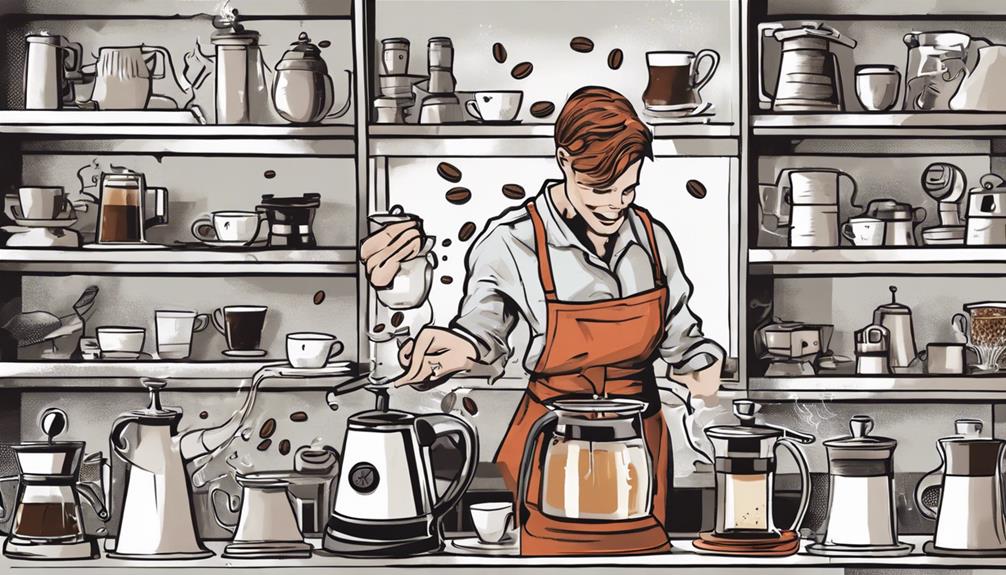
To achieve a perfect cup of coffee, understanding the various brewing methods and their unique characteristics is essential. Different coffee brewing methods like the French press, Moka pot, and pour-over coffee offer distinct strengths and flavors.
For a milder taste, automatic drip machines are popular, while French presses provide a bolder and richer coffee experience. It's pivotal to match the brewing method with your specific taste preferences to enjoy your coffee to the fullest.
The French press is renowned for its full-bodied coffee, achieved through steeping coarsely ground coffee beans in hot water before pressing them down with a plunger.
On the other hand, the Moka pot creates a strong and robust coffee similar to espresso by passing water through coffee grounds under pressure.
For a more delicate and nuanced flavor profile, pour-over coffee involves slowly pouring hot water over coffee grounds in a filter, allowing for a precise and customizable brewing process. Understanding these different methods will help you choose the best one to suit your coffee preferences.
Cleaning Equipment
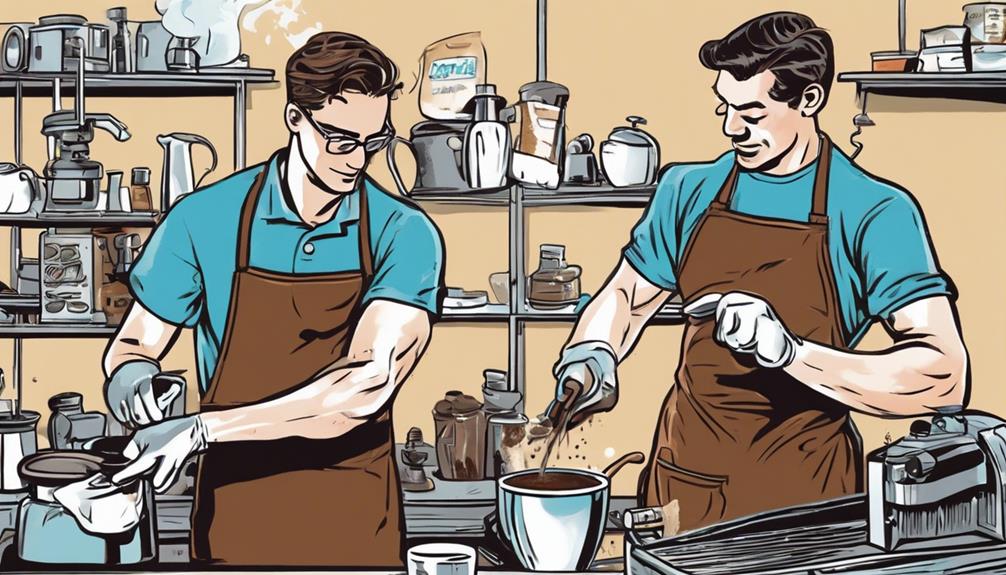
Maintaining the cleanliness of your brewing equipment is key to preserving the quality and flavor of your coffee. To maintain your equipment functions at its best and your coffee tastes delicious every time, follow these essential cleaning tips:
- Regular Cleaning: Clean your coffeemaker regularly to prevent oil buildup that can impact the flavor of your coffee.
- Daily Cleaning: Make it a habit to clean your equipment daily to maintain top-notch coffee taste and prevent a burnt flavor in your brew.
- Gentle Cleaning Solutions: Opt for gentle cleaning solutions instead of harsh chemicals to preserve the quality of your equipment.
- Prevent Off-Flavors: Avoid a stale or off-flavor in your coffee by keeping your equipment clean and well-maintained.
- Proper Maintenance: Maintain proper maintenance of your coffee brewing equipment to guarantee a consistent and delicious cup of coffee each time you brew.
Understanding Coffee Origin

Understanding the source of your coffee beans is essential for appreciating the diverse flavor profiles that different regions offer. The origin of beans greatly influences the taste of your brew. For example, African beans are known for their dark and acidic profiles, while Guatemalan coffee offers a complex and balanced taste. The acidity levels in coffee can vary based on where the beans were cultivated.
By knowing the origin of your coffee grounds, you can better grasp and enjoy the different flavor profiles that each region brings to your cup.
When brewing at home, consider exploring coffees from various regions to experience a range of flavors. The geographical location where coffee is grown plays a significant role in determining its taste characteristics. Experimenting with different origins can help you develop a palate for distinct flavors, enhancing your home brewing experience.
Flavoring Coffee
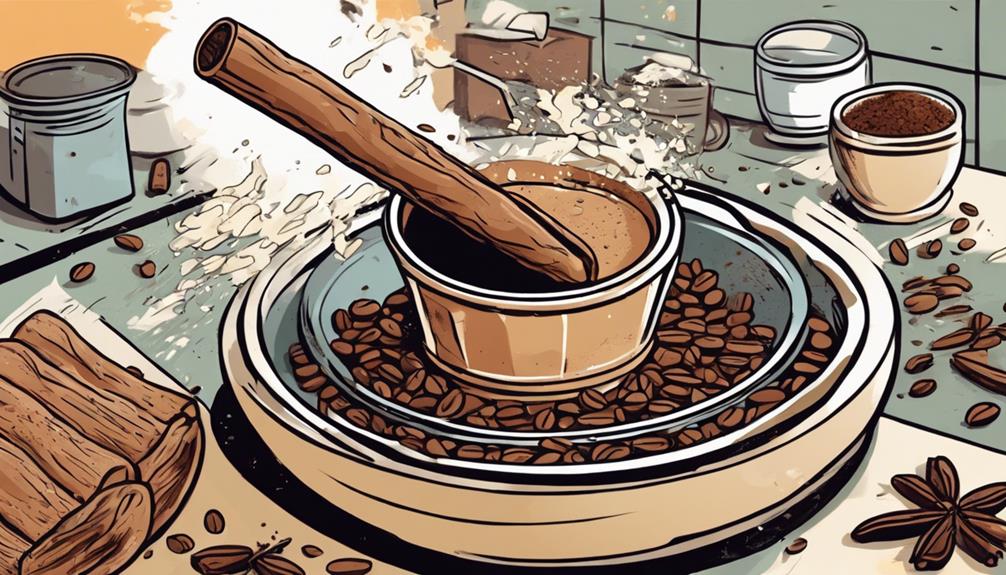
Enhance your coffee experience by adding natural ingredients or spices to create unique flavor profiles that cater to your personal taste preferences.
When flavoring your coffee at home, consider the following tips:
- Experiment with natural ingredients like cinnamon, chocolate pieces, or spices for an extra kick of flavor.
- Avoid artificial syrups and opt for natural flavorings to maintain a more authentic taste.
- Top off your flavored coffee with whipped topping for a creamy and indulgent finish.
- Get creative with spices such as nutmeg or cardamom to infuse your coffee with a unique and aromatic twist.
- Enjoy the freedom of customizing your coffee to suit your preferences, making each cup a delightful and personalized treat.
Frequently Asked Questions
How to Make Barista Quality Coffee at Home?
To make barista-quality coffee at home, start with freshly roasted whole beans and use a burr grinder for a consistent grind. Maintain the right coffee-to-water ratio and temperature, try various brewing methods, and keep your equipment clean for best flavor.
What Is the Best Way to Brew Coffee at Home?
Brewing coffee at home, it's all about you! Choose your method wisely, focusing on water quality, bean origin, and grind size. Invest in quality beans, a burr grinder, and a scale for the perfect brew every time.
How Do You Make Coffee at Home Like a Cafe?
To make coffee at home like a cafe, start with freshly roasted beans and filtered water. Invest in a quality grinder, experiment with brewing methods, and pay attention to water quality and temperature. Enhance with syrups or spices for that cafe-inspired touch.
How to Make Barista Style Coffee at Home Without Machine?
To make barista-style coffee at home without a machine, use a French press. Grind beans to a medium-coarse consistency, control water temp between 195-205°F, experiment with ratios, and practice steaming milk for latte art. Enjoy your cafe-quality brews!
Conclusion
Now that you've learned the basics of home brewing, remember that 80% of the flavor in your cup of coffee comes from the quality of the beans and the brewing process.
By selecting the right beans, measuring and grinding them properly, and using good water quality, you can brew a delicious coffee at home just like a barista. Becoming a coffee drinker is more than just making a beverage – it’s about understanding and appreciating the complex flavors and aromas that coffee has to offer. Experimenting with different brewing methods and finding the perfect roast for your taste preferences can help you develop a deeper love and respect for coffee. With a little practice and patience, you can elevate your home brewing skills to rival that of your favorite coffee shop.
Keep experimenting with different brewing methods and flavors to find your perfect cup!


